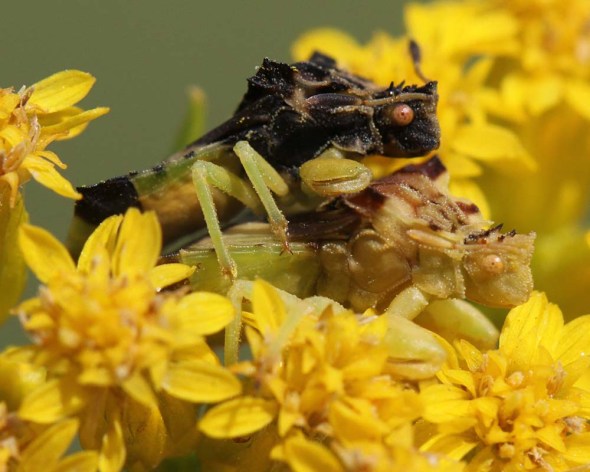Ambush Bugs Courting
 Ambush Bugs are true bugs, in the order Hemiptera. (Although insects are often referred to as “bugs,” technically, only insects in this order are considered and referred to as bugs by entomologists.) All true bugs have piercing and sucking mouthparts, and wings which are membranous and clear at the tips, but hardened at the base.
Ambush Bugs are true bugs, in the order Hemiptera. (Although insects are often referred to as “bugs,” technically, only insects in this order are considered and referred to as bugs by entomologists.) All true bugs have piercing and sucking mouthparts, and wings which are membranous and clear at the tips, but hardened at the base.
Ambush Bugs are usually brightly colored (yellow, red or orange) and have thickened front legs which are used to capture prey up to ten times their own size. They live up to their name, patiently lying in wait, motionless, often in goldenrod flowers where they are very well camouflaged, for unsuspecting prey. The Ambush Bug, upon sighting prey, suddenly seizes the prey in its powerful forelegs and quickly dispatches it with a stab from its sharp beak. It then injects digestive enzymes into its prey, after which it drinks the resulting liquid innards.
This time of year you often see the smaller males riding around on the backs of the larger females while the females continue to feed. This behavior is part of the courtship ritual – males actively guard their mate prior to and following copulation. Mating takes place side by side, after which the female deposits her eggs among the leaves or on the stems of flowering plants. Look for Ambush Bugs in yellow and white flowers, especially goldenrod.
Naturally Curious is supported by donations. If you choose to contribute, you may go to http://www.naturallycuriouswithmaryholland.wordpress.com and click on the yellow “donate” button.


















Hi Mary, We wondered if you could identify a very tiny clamshell in the outlet to our pond. It was empty, and 1/4 in. long. Itâs beautifully proportioned, just like a big one, kind of greyish and smooth. What could it be. Thanks for your time. Jane Pincus and Grandson Caleb
>
August 19, 2015 at 8:10 am
Hi Jane,
My guess (and it is a guess!) is that you have a species of Fingernail or Pea Clam, a bivalve in the family Sphaeriidae. It is the common small clam you find in ponds, and even springs and small streams. Most kinds live for one to two years, but some live as lnog as three years. One species completes its development in a month or less! And some species can withstand drought for several months by burrowing into the mud. Hope this helps you and Caleb! Mary
August 19, 2015 at 9:48 am
Fabulous photo and text.
August 19, 2015 at 8:37 am
Thank you so much, Jean.
August 19, 2015 at 9:48 am
Holy moly! Those are two of the strangest looking bugs I’ve ever seen – faces only a mother could love! It took me a while to figure out what I was seeing. What a remarkable photo (once again)! Thanks!
August 19, 2015 at 2:21 pm
Am curious as to whether Ambush Bugs are useful and therefore desirable. I think I found some of the eggs on a yellow flowering plant today (Sept 11).
September 11, 2015 at 9:22 pm
Hi Kate,
It’s my understanding that ambush bugs are generalists, preying upon and eating a wide range of insects, some of which are considered pests, some not. I do know that their ability to capture honeybees makes them undesirable from a beekeeper’s point of view, but otherwise, I wouldn’t classify them as “good” or “bad” insects.
September 12, 2015 at 6:51 pm